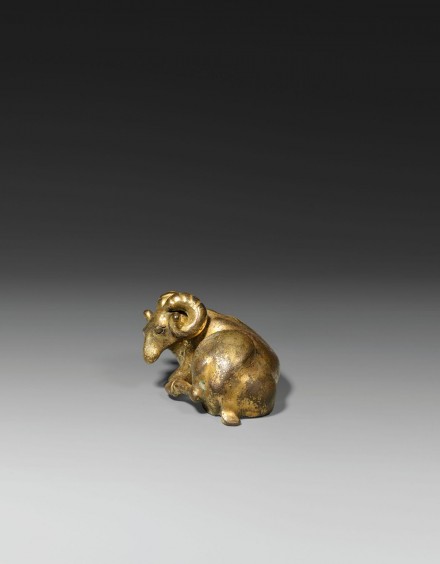J.J. Lally & Co., Oriental Art / New York City, New York
MenuPast Exhibition
Ancient Chinese Bronzes
March 19 - April 9, 2011

19.
A GILT BRONZE RAM-FORM WEIGHT
Western Han Dynasty (206 B.C. – A.D. 8)
the recumbent animal well modelled in a quiet pose with head turned to the left and slightly raised, with three legs held in close to the body and one hind leg modelled in the round, the muscular body smoothly contoured and the small, stylized tail curled down at the rump, the large horns powerfully curved and deeply ribbed, the richly gilded surface showing natural wear exposing the bronze beneath, with some light green encrustation and warm reddish-brown patination, the interior filled with lead amalgam.
Length 3 3⁄8 inches (8.6 cm)
In Han China people customarily sat on woven mats on the floor. Sculpted weights were placed at the corners of the floor mat as a luxurious decoration and a display of rank. The image of a ram is symbolic of good fortune in China because the pronunciation of the word for “ram” (yang) closely mimics the pronunciation of the word for “auspicious” (xiang); and the ram has been a popular image in Chinese art since antiquity.
Compare the similarly modelled bronze ram-form weight excavated from a Western Han tomb in Hebei, illustrated in a line drawing by Sun, “Han zhen yishu” (Notes on the Design and Manufacture of Weights in the Han Dynasty), Wenwu, 1983, No. 6, p. 70, fig. 7. Another similar bronze ram-form weight excavated from a Chu State tomb in Jiangling, Hubei is illustrated in Kaogu, 1980, No. 5, pl. 5:1.
For a discussion of the forms of ancient Chinese weights and their function, see the catalogue of the Isabella Stewart Gardner Museum exhibition by Wang, A Bronze Menagerie: Mat Weights of Early China, Boston, 2006.
西漢 鎏金銅羊鎮
長 8.6 厘米
19.
A GILT BRONZE RAM-FORM WEIGHT
Western Han Dynasty (206 B.C. – A.D. 8)
Length 3 3⁄8 inches (8.6 cm)